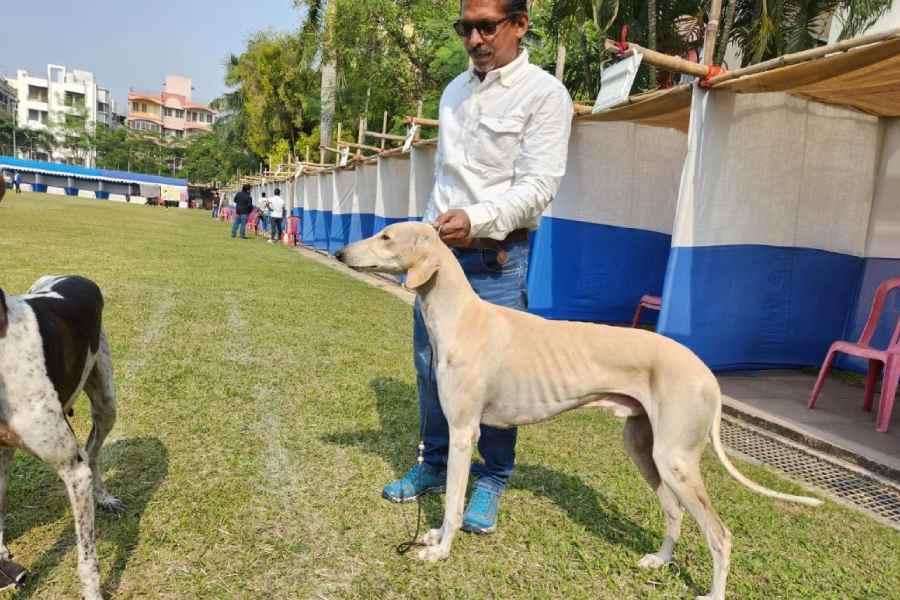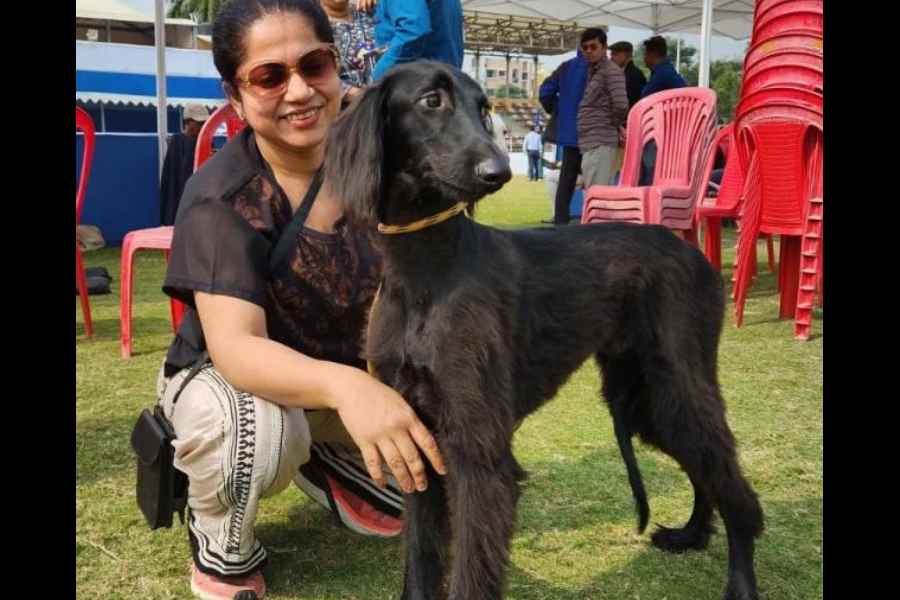How much do you know of India’s canine heritage? Can you tell a Pashmi from a Rampur hound? Do you know which dog Tipu Sultan used in his army? Do you know which Indian dog has a pink nose?
The Society for Indian Breeds of Dogs Kolkata Chapter organised a speciality show that they say was a first for Bengal. It was held at New Town’s NKDA Football Stadium where they shared the ground with a Calcutta Canine Club show. “This was, in fact, the mother society’s first show outside Karnataka and we had 30 entries,” said Imtiaz Qasem, secretary of the society.
He added that about 60 Indian breed dogs were registered under Kennel Club of India from Bengal and that the objective of the show was to encourage people to keep these breeds.
There are nine KCI-registered Indian breeds of which five participated. There were no Chippiparai, Kanni, Rampur hound and Himalayan Sheep Dogs that day. But the others generated much interest among visitors. The Telegraph Salt Lake met them -
Pashmi
Origin: These are sight-hounds of Maharashtra. Pashmis can be seen in countless medieval Indian paintings of royalty going boar-hunting, where the dogs would help with the hunt. Pashmi means “soft gold” in Persian and the breed is named after its soft silky coat.
Description: The Pashmi is an elegant, slender, medium-sized dog. It has a long, thin head and flowing fur, especially on its ears and tail. They resemble the Saluki dog but are less furry and more reserved than their Middle Eastern cousins.
Parent speak: Shreyasee Bhaduri sang praises of her Pashmi, Abanee. “I’ve had a Labrador and Lab-Golden Retriever mix before but after Abanee I’ve decided never to return to foreign dogs,” she said.
Bhaduri said the dog was intelligent and hardy. “I never have to take him to the doctor for any illness,” she said. “I don’t care about shows and prizes. I’m training my Pashmi to be my trekking partner.”
Mudhol hound
Origin: The breed gets it name from the Mudhol region of Karnataka, where it is popular. In the early 20th century, a ruler of Mudhol, Shrimant Rajesaheb Malojirao Ghorpade, noticed tribals using this dog to hunt. They would call them “bedar,” meaning fearless. Using selective breeding, the king revived the breed and on a visit to England, gifted a pair to King George V, bringing the breed global attention. Today the Indian army and police are using Mudhols.
Description: Mudhol hounds have long, narrow heads that are broad between the ears and the ears themselves are long and pendulous. They are muscular and are known for agility and stamina.
Parent speak: “Leo runs like a horse,” says Akash Ghosh. “We had a Spitz before but upon researching breeds for our next dog, realised Indian ones are getting rare. We are glad we got a Mudhol.”
Leo loves people, especially children, who even put their hands in his mouth while playing. “He’s as comfortable in an air-conditioned room as he is in 50-degree heat and loves running,” says Akash. But he’s a mama’s boy. “If my mom leaves home, he cries so much that neighbours have to call her up to summon home quickly.”
Caravan hound
Origin: This dog originates from around Maharashtra and was named so as it would faithfully accompany caravans and military entourages.
Description: The Caravan hound is a lean but strong dog with agility and stamina.
Parent speak: Sukanta Thakur has three Caravan hounds – the fawn-coloured male Shashikanta, his black-and-white mate Rangabati and their son Oreo, who is jet black in colour. “We have more dogs at home- Golden Retriever, Pomeranian, Beagle but these Indian ones are our pride,” said Thakur.
He praised their immunity and adaptability. “They seem to bond with us even more than foreign breeds. We are the world for them and they want nothing else. They have strong guarding and hunting mentality too,” said the man who’s had a Mudhol and Rampur hound too.”

A Caravan hound prepares to hit the ring Brinda Sarkar
Rajapalayam
Origin: This breed is documented in the subcontinent as early as the 18th century. They are said to have been cultured by royals of Tamil Nadu and are named after a town there. The king of Mysore, Tipu Sultan, used these dogs to attack the British cavalries during wars and the Indian army too is using them now.
Description: Rajapalayams are beautiful dogs. Most are milky-white in colour and have pink noses. They have button ears (where the top of the ears fold over), and their eye colour can range from brown to green and even golden. They are muscular-built and have deep chests, making them suitable for speed.
Parent speak: Apple and Sweetu were two of the most gorgeous dogs are the show but their owner, Arnab Das, said he hardly had to groom them. “I have seven Rajapalayams at home. They love rolling in the grass but still remain this clean. I didn’t even have to bathe them before this show.”
Das runs an NGO for animals, and having seen how badly people treat street Indies, has a soft corner for Indian-origin dogs. “If these breeds are visible at shows, they shall become popular and will be in demand. Their lineage will be protected,” he said.
Kombai
Origin: The Kombai is a working dog native to Tamil Nadu and has been named after the place Kombai. They were traditionally owned by zamindars for hunting, and it was they who gifted the breed to Tipu Sultan and his father Hyder Ali, to be trained for warfare.
Kombais were so coveted back in the day that people would even exchange them for horses.
Description: The Kombai dog is a stubby, powerful and athletic breed with a reddish-brown coat and black muzzle. They are affectionate towards their families and fierce when threatened, making them natural guard dogs.
Parent speak: “Don’t go by his looks. He’s killed a 60kg Rottweiler,” warns Ramanan Muthusamy and visitors too two steps back. Muthusamy had come from Madurai for the show.
“My dog is a guard and he doesn’t forget his nature even at shows. So I’ve kept his cage covered to remove anything that might alert him,” said the advocate and dog trainer, adding that once, by mistake, the cages of his Kombai and a Rottweiler were left open and the former wrestled the latter to death. “This breed is comparable to Pitbulls and Belgain Melaniois.”
At dog shows in south India these days, Muthusamy said, there were a sizeable number of Indian breeds, maybe 25 Rajapalayams and almost as many Chipiparais. Kombais too are catching up. “I’m happy to return to Bengal if there are more such speciality shows,” he said.
